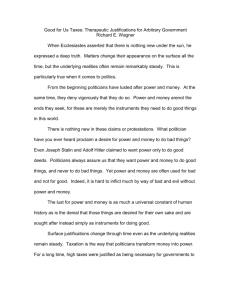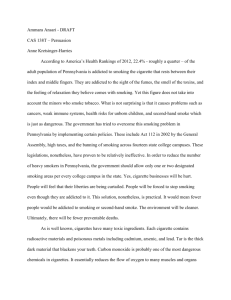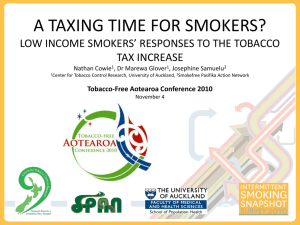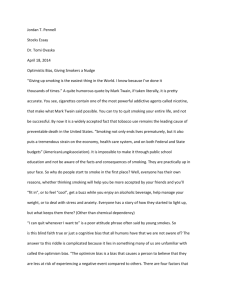Negative externalities: smoking
advertisement
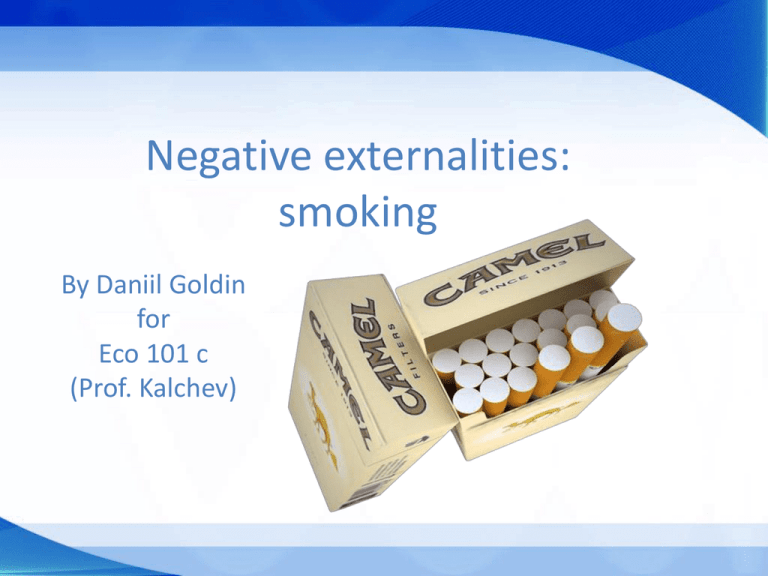
Negative externalities: smoking By Daniil Goldin for Eco 101 c (Prof. Kalchev) Some basic statistics: • Tobacco is grown in >100 countries, mostly developing ones • China is the world’s largest producer, followed by USA, India, Brazil and Turkey. These 5 countries produce 2/3 of global output • Russia cigarette consumption: o 2786 cigarettes a year (per person) o Smoking is highest among those aged 14-18: 47,9% of men and women in this age group smoke o Smoke starting age is extremely low: 11-14 yrs. o Every year about 400.000 smokers die as a result of their habit o The government earn about $ 5 billion a year in revenue from tobacco duty and VAT The private and social costs of smoking • • • • • • smoking creates a difference between private and social costs and benefits Cigarette consumers derive a private benefit from smoking and their habit entails a private cost But the act of consumption creates negative externalities so that the social cost exceeds the private cost. It is unlikely that smokers do consider the external costs they’re creating while lighting up. Smokers may also suffer from information failure- so that they’re not fully aware of the long term damage created by their habit (i.e over-estimating the private benefit they get) If smokers fail to consider the externalities they generate, then market failure will occur- leading to a loss of social welfare Many of these externalities are impossible to value accurately in monetary terms because on the impact on human life The market failure • Consumption of cigarettes produces external costs • Therefore the social costs exceeds private costs • Private optimum is where marginal private cost (the cost of an additional unit consumed) equates with the marginal private benefit (the satisfaction from an extra unit) • Social optimum takes into account the social cost • Without intervention, the self-interest of the smokers will lead to cigarettes being over- consumed and under-priced by the market • Without a “market for pollution” smokers can continue to pollute without penalty Illustrating market failure Private costs of smoking • Consumption: – A 20-a –day smoker spends about $ 1700 a year on cigarettes. People with low income eventually spend more than the wealthier ones – Cigarettes are products with a negative income elasticity on demand (i.e an increase in income will lead to a fall in the demand and may lead to changes to more luxurious substitutes.) • Health costs: – About half of regular smokers will be eventually killed by their habit- e.g. through lung cancer, chronic obstructive lung disease and coronary heart disease • Increased health Insurance costs: – Premiums are higher for smokers The external costs: • Costs to the NHS of treating smoking- related diseases • Smoking itself is regarded as a major source of health inequalities • Lost output/ productivity from working days lost and absenteeism caused by smoking- related diseases • Increased pressure on the welfare state/ benefits system to finance those unable to work because of long term illness plus the benefits paid to dependents of those who die young • Costs created by household fires linked to smoking • Cigarettes are major source of street litter • Cleaning and building maintenance costs Taxation of cigarettes: • Over 80% of the final retail price is tax (VAT and excise duty) • The aim of higher taxation is to in crease the real cost of purchasing and consuming cigarettes • Higher prices should control demand by reducing the real incomes of smokers and increasing an opportunity cost of continuing to smoke • Lower consumption rates reduces output towards the social optimumreducing the extent of market failure • Taxation is also justified on the grounds of “making the polluter pay” for the external costs that are created • Extra revenue fro taxation can be used to fund improvements I health care • The revenue from taxes could be allocated to promote alternatives to tobacco growing and manufacturing Health awareness might reduce demand THANK YOU FOR WATCHING!!!



